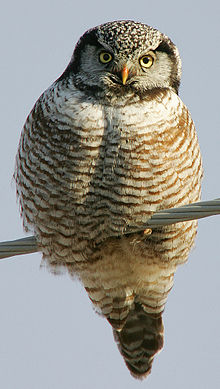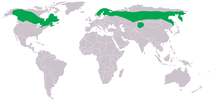- Northern Hawk-Owl
-
Northern Hawk-Owl 
Conservation status Scientific classification Kingdom: Animalia Phylum: Chordata Class: Aves Order: Strigiformes Family: Strigidae Genus: Surnia
Duméril, 1806Species: S. ulula Binomial name Surnia ulula
(Linnaeus, 1758)
The Northern Hawk-Owl (Surnia ulula) is a non-migratory owl that usually stays within its breeding range. It sometimes irrupts southward.
Contents
General
It is the only living species in the genus Surnia. The species is sometimes called simply the Hawk Owl; however, many species of owls in the Ninox genus are also called hawk owls.
Description
The Northern Hawk-Owl (Surnia ulula) also known as the Hawk-Owl is an owl from the family (Strigidae) which resides within the circumpolar regions in the northern hemisphere. Male Northern Hawk-Owls are generally 36.0–42.5 cm long and weigh 300 g. Females are slightly bigger with a length of 37.2–44.7 cm and a mass of about 340g. Both male and female have similar wingspans of about 45 cm. The Northern Hawk-owl plumage is relatively dark brown with an off white spotting pattern on all dorsal parts of the body with the exception of the back of the neck which boasts a black v-shaped pattern. The underbelly is generally white or off-white which continues to the toes with brown bands on the breast and stomach. It also boasts a long tail with brown banding. The Northern Hawk-Owl has a smokey white face with a black border, a flat head, yellow eyes and a yellow curved beak.[1]
The Northern Hawk-Owl has been said to resemble a hawk in appearance and in behavior. More precisely it is said to look like the Cooper ’s Hawk (Accipiter cooperii). It has been suggested that this may be because the Hawk-Owl may partially fill an important diurnal niche similar to that of day hunters such as hawks.[2]
Vocalization
S. ulula has a variety of calls used by the different sexes in different situations. When attracting a mate the male usually lets out a rolled whistle of ulululululululul and a sound similar to tu-wita-wit, tiwita-tu-wita, wita, when perching at a potential nest site. The female’s call is usually less constant and more shrill.[1]
When alerting to danger, the Northern Hawk-Owl lets out a sound similar to rike, rike, rike, rike. It also releases a high pitched scream followed by a yip when an intruder is near to the nest. To warn of impending dangers to a fledgling, the Hawk-Owl will let out a noise similar to ki ki kikikikiki. Calls can vary in length from 15 s to 2 min.[1]
Breeding
The Northern Hawk-Owl generally starts its mating rituals at the beginning of March.[1] After calling and pairing is complete the Northern Hawk-Owl will build a nest and start to lay eggs. On average the Northern Hawk-Owl will lay 3-11 eggs per brood. The nest sites are usually the tops of hollow stumps of old dead spruce trees. These nesting sites are usually 2-10m above ground for the North American S. u. caparoch and approximately 4-5m above ground for the Eurasian S. u. ulala. The specific dates of egg appearance can be quite variable depending on locality. In central Canada eggs are usually laid from March 30 to the 5th of June. In Newfoundland the appearance eggs occurs later, between May 9 and June 11. In Finland however, eggs can be found anywhere between the 30th of March to the 23rd of June.[3]
For the most part the female Northern Hawk-Owl does the incubating of the eggs whilst the male forages for food. Once the chicks have hatched their roles shift drastically. At about two weeks into the chicks lives the female starts to leave the nest for long spans of time (5 hours or more). This span of time is presumably when the female hunts. The male however, will guard the nest diligently until the chicks leave. When predators (usually other raptors) fly nearby, the male will sometimes chase them away from the nest if they feel it is necessary. Once the owlets have grown to a size which allows less parental supervision, they will leave the nest. This occurs on average after their 21st day, and can begin as early as mid-June. After this the female will provide most of the care. However the male will remain close and will still feed his young on occasion.[3] The Northern Hawk-Owl has also been known to nest on cliffsides. It has little fear of humans, and will attack if the young are approached too closely.
Habitat and Distribution
The Northern Hawk-Owl is distributed throughout the boreal forests of the world. In North America, the Northern Hawk-Owl can be seen as far north as the Alaskan tree line and the northern Canadian territories. Occasionally, the Hawk-Owl can extend its territory as far south as northern Minnesota and many other states in the northern United States including more central states such as West Virginia, New York, and South Dakota. These southern forays into the northern United States are rare and generally occur during winter, or following an explosion in a population of prey. The normal distribution however, tends to be throughout Canada from the Alaskan coast to the northern portion of Newfoundland.[1]
In Eurasia, again the Northern Hawk-Owl’s range is throughout the boreal forest, usually found in northern Scandinavia, northern Russia to central Russia and northern Mongolia . As in North America the Northern Hawk-Owl can occasionally be found in more southern areas such as the following: Great Britain; and southern Russia and Scandinavia, following explosions of prey.[1]
Feeding
The Northern Hawk-Owl feeds on a variety of prey which can include small rodents to mammals more robust in size and a variety of birds,[3] a typical diet for many boreal owls.[1] In Eurasia the Northern Hawk-Owl is known to feed primarily on voles from the Microtus family. These voles usually follow a 3-4 year cycle of abundance. Therefore, S. u. ulula numbers are affected negatively when the numbers of voles are lowest. In North America the subspecies S. u. caparoch also feeds upon microtine voles, but its population is primarily based on the ten year cycling of the Snowshoe Hare (Lepus americanus). In Eurasia the Northern Hawk-Owl’s body mass consists of about 94 % microtine voles, whereas in North America the percentage of biomass contributed by voles can be as low as 20 %. Juvenile hares are considerably more important at 40-50%.[4]
Other animals which are important prey items for the Northern Hawk-Owl include the red squirrel (taniasciurus handsonicus) which has been documented contributing 20% to the Hawk-Owl’s biomass.[3] A long list of others include mice, rats, voles, lemmings, the short-tail weasel (Mustela erminea), partridge, Spruce Grouse (Falcipennis canadensis), doves, Pileated Woodpeckers (Dryocopus pileatus), sparrows, jays, robins, starlings, buntings, grackles, and finches.[1] In the winter feeding strategies change, where in summer the main source of food is mammals, in the winter a bigger portion of the Hawk-Owl’s biomass consists of ground dwelling birds such as the ptarmigan and the grouse.[1]
The Northern Hawk-Owl, is a partially diurnal hunter although it has been recorded hunting at varying times and does not appear to have a preferred hunting time.[1] Whether the bird resides in Eurasia or North America, the strategy is usually similar. The Northern Hawk-Owl will perch and scower the immediate area for prey.[3] As theseowls are considered a search orientated species they likely do not stay put for long if the site is not producing prey.[2] The Hawk-Owl prefers open forest type environments when perching. These environments include sphagnum bogs and partially deforested areas. The preferred perching tree of the Northern Hawk-Owl is the spruce tree. When the Hawk-Owl attacks, it goes from a horizontal posture into a gliding dive. If the prey is further away the bird will flap its wings a few times during the dive to increase distance.[3] The Hawk Owl has exceptional hearing and can plunge into snow to capture rodents below the surface.
The type of prey the Hawk-Owl catches will determine its eating strategy. For mammalian prey the ritual is generally the same, the Northern Hawk-Owl will eviscerate its prey, eat the head first especially for prey like the red squirrel whose head is fairly large, and then it will either eat the organs and cache the remains for bigger prey, organisms or swallow the body whole for smaller prey animals.[3]
Taxonomy
The genus Surnia contains only one species, the Northern Hawk-Owl (Surnia ulala). However, there are three recognized subspecies. The North American variety of Northern Hawk-Owl S. u. caparoch has been known to reach Great Britain at times but generally resides in Canada and Alaska. In Eurasia there exists two sub-species. One variety, S. u. tianschanica, breeds in central Asia reaching Xinjiang (China). The other variety, S. u. ulula, resides across Eurasia reaching Siberia at its most eastern range.[1]
The Northern Hawk-Owl is in the family Strigidae, but there is no known fossil evidence of others in its genus. There have been genetic tests done however, which relate the S. ulula to other species such as the Spotted Owlet (Athena brama) and the Little Owl (A. noctua).[1]
References
- BirdLife International (2004). Surnia ulula. 2006. IUCN Red List of Threatened Species. IUCN 2006. www.iucnredlist.org. Retrieved on 11 May 2006.
- ^ a b c d e f g h i j k l Duncan, James R. and Patricia A. Duncan. 1998. Northern Hawk-Owl (Surnia ulula), The Birds of North America Online (A. Poole, Ed.). Ithaca: Cornell Lab of Ornithology; Retrieved from the Birds of North America Online: http://bna.birds.cornell.edu/bna/species/356 doi:10.2173/bna.356.
- ^ a b Sonerud, Geir A. 1992. Search tactics of a pause-travel predator: adaptive adjustments of perching times and move distances by hawk owls (Surnia ulula). Behav Ecol Sociobiol. 30: 207-217.
- ^ a b c d e f g Kertell, Kenneth. 1986. Reproductive biology of Northern Hawk-Owls in Denali National Park, Alaska. Raptor Research. 20(3/4):91-101.
- ^ Rohner, Christoph, James Smith, Johan Stroman and Miranda Joyce. 1995. Northern Hawk-Owls in the nearctic Boreal Forest: selection and population consequences of multiple prey cycles. The Condor. 97:207-220.
External links
- Northern Hawk-Owl videos, photos & sounds on the Internet Bird Collection
- Northern Hawk-Owl - Cornell Lab of Ornithology
- Northern Hawk-Owl Information and Photos - South Dakota Birds
- Northern Hawk-Owl - eNature.com
- Stamps
 Media related to Surnia ulula at Wikimedia Commons
Media related to Surnia ulula at Wikimedia Commons Data related to Surnia ulula at Wikispecies
Data related to Surnia ulula at Wikispecies- Surnia ulula in the Flickr: Field Guide Birds of the World
- Surnia ulula on Avibase
- More information on the Northern Hawk-Owl
- Species at Risk Public Registry
- Hawk-Owl flight pictures
Categories:- IUCN Red List least concern species
- Surnia
- Owls
- Genera of birds
- Monotypic bird genera
- Birds of Canada
- Birds of the United States
- Animals described in 1758
Wikimedia Foundation. 2010.

